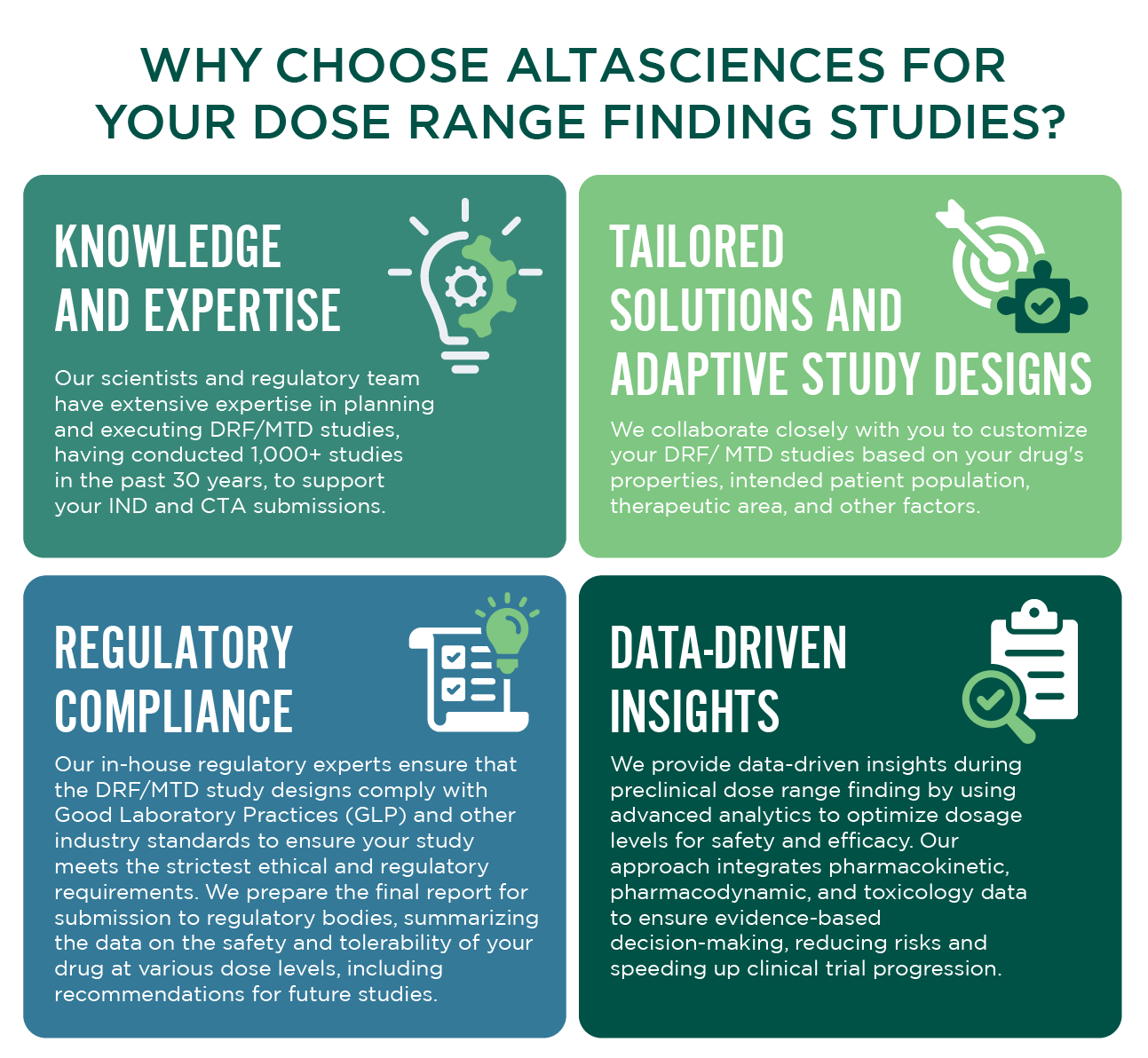DOSE RANGE-FINDING STUDIES
At Altasciences, we specialize in customized dose range finding (DRF) and maximum tolerated dose (MTD) studies designed to meet your unique drug development needs and therapeutic areas. Having conducted thousands of studies in the past 30 years, we deliver accurate, reliable results to support your IND filing. Determining the right dosage range is crucial in preclinical safety assessments. Our DRF and MTD studies pinpoint the ideal dose for your GLP IND-enabling studies, ensuring your drug candidate is ready for safe and effective evaluation before advancing to first-in-human trials.
Contact us to discover how our expertise can help accelerate your drug development process while ensuring regulatory compliance.
DOSE RANGE FINDING STUDIES IN EARLY-PHASE DRUG DEVELOPMENT
A dose range finding (DRF) study has two key purposes: first, to determine the safe and effective dose range by identifying the minimum effective dose (MED) and maximum tolerated dose (MTD) for future studies. Second, it collects valuable data on how the drug behaves at different doses, helping to design more focused and efficient subsequent studies. This approach minimizes unnecessary animal testing and optimizes resource allocation.
Our toxicologists regularly conduct initial in vivo toxicity tests to establish your drug’s proper dosage, frequency, and delivery method. We also provide flexible study designs for defining doses our scientists can use in future studies.
DOSE RANGE FINDING STUDY SERVICES AND EVALUATIONS
Study Dosing Routes
The choice of dosing route is influenced by factors such as the drug's properties, the intended method of administration in humans, and study objectives. Multiple dosing routes, where applicable, can offer a more comprehensive understanding of a compound's toxicity profile. Our expert toxicologists can help determine the most suitable dosing route(s) for your drug.
- Oral
- Intravenous
- Intraperitoneal
- Subcutaneous
- Dermal
- Inhalation
Evaluations in Dose Range Finding Studies
Several evaluations are carried out to assess a compound's toxicity profile, helping to identify potential adverse effects at various dose levels. These evaluations include:
- Clinical observations
- Body weight and food consumption
- Clinical pathology
- Organ weight and gross pathology
- Histopathology
- Toxicokinetics
- Other specialized assessments (e.g., ocular toxicology, developmental and reproductive toxicology)
Our scientists will tailor these evaluations to meet the needs of your specific test article.

NEXT STEPS
Partner with experts who bring the experience and commitment to quality needed to navigate DRF/MTD studies with confidence—setting the stage for a successful drug development journey.
OUR FULL SPECTRUM OF PRECLINICAL RESEARCH SERVICES
Dive deeper into Altasciences' extensive range of preclinical research services. From early-phase development to clinical trial readiness, our comprehensive offering ensures a seamless transition through each stage of drug development.
DOSE RANGE FINDING STUDIES – FAQS
What is the purpose of a dose range finding study in preclinical research?
In preclinical research, a dose range finding study determines the ideal dosage range to be used to conduct the definitive GLP IND-enabling studies, and further safety and efficacy tests of a novel therapy.
What are the key outcomes of a dose range finding study?
The following are the main results of a dose range finding study:
- Determining the Minimum Effective Dose (MED)―the lowest dosage required to achieve the intended therapeutic outcome.
- Finding the Maximum Tolerated Dose (MTD)―the maximum dosage that can be given without having a significant negative impact or causing toxicity.
- Identifying the Dose-Response Relationship―determining a therapeutic window by comprehending how various dosages impact the biological response.
- Providing a Safety Profile―preliminary information about possible toxicities or adverse effects at different dosage levels.
- Guiding Future Research―information to aid in planning upcoming clinical, pharmacokinetic, and pharmacodynamic investigations.
What is the process for conducting a dose range finding study?
The following procedures are commonly involved in the conduct of a dose range finding study:
- Study design and dose selection to find safe and effective doses by examining a wide range.
- Dosage administration through the appropriate routes of administration (oral, intravenous, subcutaneous, dermal, inhalation, etc.)
- Toxicity and efficacy monitoring to identify side effects and therapeutic reactions.
- Pharmacokinetic (PK) and pharmacodynamic (PD) evaluations to assess the ADME of the drug substance as well as its impact on biological processes, linking dosage levels to therapeutic outcomes.
- Data analysis to ascertain dose-response relationship, maximum tolerated dosage (MTD), and minimal effective dose (MED). This aids in defining the range of safe and efficient dosages for further research.
- A report summarizing the results includes suggestions for the optimal dose range to apply in further investigations, such as clinical safety and efficacy trials.
What regulatory considerations should be addressed in dose range finding studies?
Key regulatory considerations for preclinical dose range finding studies include:
- Choosing an appropriate study design, route of administration, and setting clear objectives;
- Adhering to the International Council for Harmonization (ICH) regulatory guidelines, ICH M3(R2) and ICH S6, which recommend the design, duration, and reporting of nonclinical safety studies. These studies must be conducted in compliance with GLP guidelines to ensure data integrity, reproducibility, and scientific rigor;
- Choosing an animal model based on the drug’s pharmacokinetic, pharmacodynamic, and toxicity profile. The animal species should have a metabolic profile that closely reflects human metabolism for reliable dose predictions;
- Scientists must ensure compliance with animal welfare regulations and ethical guidelines;
- Studies must include low, mid, and high doses to identify the dose-response relationship. The dosing range should be based on prior information, such as pharmacology, in vitro data, and data from similar compounds (e.g., in the same therapeutic class);
- Full documentation of the study design, methods, results, and analyses must be provided and submitted as part of the Investigational New Drug (IND) application to the FDA or the Clinical Trial Application (CTA) to other regulatory authorities.
How can you decide if you need GLP studies versus non-GLP studies?
Both non-GLP and GLP DRF studies help determine safe and effective doses, but with varying levels of detail and regulatory significance.
Non-GLP studies use simpler designs and smaller animal groups to provide an initial estimate of a drug’s dose range. While useful for early-stage decisions, these studies are not suitable for regulatory approval.
GLP DRF studies, on the other hand, adhere to rigorous protocols and involve larger animal groups, providing precise and reliable data needed for regulatory submissions. This high-quality data paves the way for further drug development and is essential for advancing to later stages.
The choice between non-GLP and GLP studies depends on the stage of your research.
RELATED RESOURCES
-
 PRECLINICAL RESEARCH SERVICES
PRECLINICAL RESEARCH SERVICES -
 ALTASCIENCES' FACILITIES
ALTASCIENCES' FACILITIES -
 PLANNING YOUR PRECLINICAL ASSESSMENT
PLANNING YOUR PRECLINICAL ASSESSMENT -
 PROACTIVE DRUG DEVELOPMENT SOLUTIONS—SMALL MOLECULES
PROACTIVE DRUG DEVELOPMENT SOLUTIONS—SMALL MOLECULES -
 PROACTIVE DRUG DEVELOPMENT SOLUTIONS—LARGE MOLECULES
PROACTIVE DRUG DEVELOPMENT SOLUTIONS—LARGE MOLECULES